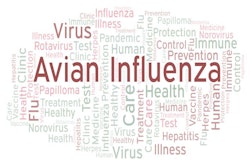
With the highly pathogenic avian influenza (HPAI) situation in poultry now regarded as stable, authorities in France have been laying out plans for the restocking of affected farms. Meanwhile, new cases have been reported over the past week among French poultry flocks, as well as those in nine other European states.
As the situation shows signs of stabilizing in the southwest of the country, French agriculture ministry has issued new guidance about the ongoing management of HPAI. Among other aspects, these include the conditions for the restocking of farms.
That there has been a recent decline in new outbreaks in this area is attributed to the ministry’s decision in late January to carry out more preventative culling of poultry.
This policy of depopulating birds across larger areas have now been completed, according to the ministry. Across France, a total of almost 4.18 million poultry have been culled. Of these, 3.44 million were in southwestern departments. In the period since January alone, depopulation has been carried out involving 350,000 ducks and 900,000 other poultry. Only exceptions to the destocking policy for uninfected birds have been hatcheries, breeding farms, and a few flocks of laying hens to maintain the national egg supply.
From March 29, restocking of young poultry (including ducks) may commence, according to the latest official announcement. However, this is only permitted under certain conditions. Firstly, at least 30 days must elapse following destocking of affected flocks. During this time, the premises must be fully cleaned and disinfected. This is followed by a further 21-day sanitation period, during which no restocking is permitted.
Finally, enhanced monitoring will be carried out on the new birds for the following three weeks.
For premises adjacent to the depopulation areas in the south-west, similar rules will apply, according to the government. Elsewhere in the country, the previous conditions apply, namely a period of 30 days before restocking may be carried out. Across France, the government is urging poultry and livestock owners as well as hunters to remain vigilant as the HPAI virus is likely to remain present in wild birds.
Slow-down in HPAI spread of HPAI in France
Summing up the disease status last week, the ministry reported there had been 366 confirmed HPAI outbreaks linked to the H5N1 virus serotype on commercial farms. Of these, 346 were in the southwest of the country.
The latest update (as of February 25) puts the number of outbreaks at 388. This total comprises 371 confirmed on commercial farms, and 17 in backyard flocks. Compared to the previous week, these are increases of seven and two outbreaks, respectively.
For commercial premises, five of the most recent outbreaks were in Hautes Pyrénées in the southern region of Occitanie, and three in the western department of Vendée. In backyard flocks, the first outbreaks of the season were confirmed in the Deux-Sèvres and Hautes Pyrénées. These departments are located in the regions of Nouvelle-Aquitaine and Occitanie, respectively, where previous outbreaks have been reported for this category.
So far this winter, 34 wild birds have tested positive for HPAI in 20 French departments, the ministry reports.
HPAI situation in poultry elsewhere in Europe
As of February 20, 17 European countries had registered one or more outbreaks in poultry so far this year. This is according to the Animal Disease Information System of the European Commission (EC). Up to that date, the system has a total of 445 outbreaks for the year. First cases of 2022 were recorded in Romania, and the figure has increased by 37 from seven days previously.
Accounting for most of the outbreaks has been France with 309 for the year so far, followed by Hungary (29), Poland (22), Italy (18), and Germany (17).
Also registering new cases through this system since February 13 were Portugal and Spain, where the national totals are four and nine outbreaks, respectively.
HPAI detected in commercial poultry in southern Europe
Of all European states, Spain has officially registered the most outbreaks over the past week. This is based on notifications to the World Organisation for Animal Health (OIE).
Over the period February 8-19, the H5N1 variant was detected on nine commercial poultry farms. All but one of these was in the southern region of Andalusia, and the other was in Castile and Léon in the north. All were in districts where previous cases have been confirmed since the start of this year. Of the almost 361,000 birds directly impacted by the latest outbreaks, more than 257,000 died. One farm affected had 180,000 poultry, while the others outbreaks were in flocks of between 6,200 and 33,500 birds.
Latest outbreaks bring Spain’s total outbreaks so far this year to 18, involving around 680,000 poultry in total.
In Portugal, the number of outbreaks linked to the same virus variant has risen to six. The latest to test positive for the virus was a farm with more than 85,000 ducks. Located in the Torres Vedras area of the Lisbon district, this municipality has been the location of all but one of the country’s previous outbreaks in 2022.
One more outbreak has been confirmed in Italy, affecting a backyard flock of 117 birds in Pavia in the Lombardy region. With previous cases confirmed in this province, it is the 14th outbreak in the country so far this year.
Directly impacted by the H5N1 HPAI virus since mid-October last year have been almost 14.7 million Italian poultry.
According to the nation’s health authority and research organization for animal health and food safety, IZSVe, 312 outbreaks have been confirmed in among Italian commercial and backyard flocks.
Further cases in The Netherlands, the U.K.
Each of these western European states has registered five new outbreaks over the past week. In each case, the presence of the H5N1 virus serotype is confirmed.
The latest Dutch outbreak registered with the OIE began on February 20. Affected were almost 9,500 meat turkeys at a farm in the most northeastern Dutch province, Groningen.
Subsequently, the Netherlands’ agriculture ministry has confirmed the presence of this virus serotype on four more premises with poultry. Three of these were commercial farms in Groningen — one with around 50,000 organic pullets, one with 16,000 turkeys, and one with 37,000 broilers.
Neighboring Groningen to the west is the province of Friesland, where the other recent Dutch outbreak occurred. This was in a small flock of about 90 waterfowl.
While confirming the presence of an H5N1 variant of the avian flu virus, all these cases were announced by the country’s government before the pathogenicity of the virus is determined. If confirmed, these latest outbreaks bring the nation’s total outbreaks since October of last year to 30, with just under 1.47 million poultry directly impacted through mortality or culling to control the spread of the virus.
Meanwhile, in the United Kingdom (U.K.), 97 HPAI outbreaks linked to the H5N1 virus variant have been confirmed so far this winter (as of February 25).
Most recently, the veterinary authority has registered with the OIE five outbreaks. Starting in the period February 7-19 were cases at two farms with a total of 11,000 breeding pheasants in Wales, and one commercial premises in eastern England with around 8,150 turkeys. Also affected were two backyard flock in the north-east of England.
New cases in two Central European states
Poland’s chief veterinary office is reporting two new outbreaks. Latest to be involved were a backyard flock in Lesser Poland (Malopolskie), and a farm with almost 30,000 meat ducks in Greater Poland (Wielkopolskie). These bring to 23 the number of confirmed Polish outbreaks so far this year.
In the Czech Republic, poultry in a backyard flock in the southwestern region of Plzen have tested positive for the H5N1 HPAI virus variant.
Hungary’s veterinary authority has notified the OIE that no new cases have been detected in the country’s poultry.
The HPAI situation in Moldova is reported as “resolved.” This is according to the latest report from the authorities there to the OIE. In early January, poultry from a large backyard flock tested positive for the H5N1 virus, but no further cases have been detected.
HPAI cases in European wild birds pass 1,000
For the year to date, HPAI outbreaks in wild birds across Europe reported to the EC animal disease system have reached 1,039 (as of February 20). This represents an increase of 77 compared with the previous week’s total. Lithuania registered its first infection in a wild bird in 2022.
Of the 24 states that have now registered cases through this system, Germany has detected the most outbreaks in wild species (511), followed by the Netherlands (218), and Denmark (61).
Also confirming with the EC new outbreaks since February 13 were Austria, Belgium, France, Hungary, Italy, Norway, Poland, and Spain.
Other nations whose agencies have notified the OIE about new outbreaks in wild birds over the past week are Croatia, Estonia, Faeroes Islands, Luxembourg, North Macedonia, Romania, and the U.K.
Lithuania’s veterinary authority has declared to the OIE that the earlier outbreak series in wild birds linked to the H5N8 and H7N7 virus serotypes are now “resolved.” For both of these variants, no new outbreaks have been reported since 2021.
View our continuing coverage of the global avian influenza situation.
















